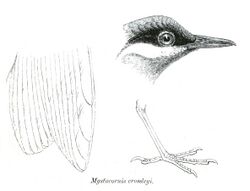Biology:Crossley's vanga
| Crossley's vanga | |
|---|---|

| |
| Scientific classification | |
| Domain: | Eukaryota |
| Kingdom: | Animalia |
| Phylum: | Chordata |
| Class: | Aves |
| Order: | Passeriformes |
| Family: | Vangidae |
| Genus: | Mystacornis Sharpe, 1870 |
| Species: | M. crossleyi
|
| Binomial name | |
| Mystacornis crossleyi (Grandidier, 1870)
| |
Crossley's vanga (Mystacornis crossleyi), also known as Crossley's babbler-vanga, Crossley's babbler, Madagascar groundhunter, or Madagascar groundjumper, is a bird species in the family Vangidae.
Taxonomy
The bird is in the monotypic genus Mystacornis. The species is an example of convergent evolution: its bill and body shape adapted to its habit of looking for insect prey in the leaf litter, eventually becoming so similar to that of ground-babblers that early naturalists initially classified the Crossley's vanga into what was then known as the babbler family, Timaliidae.[2]
Description
Crossley's vanga is a small babbler-like bird, 15 cm long and weighing around 25 g. Its most distinctive feature is the olive-grey bill, which is disproportionately long and slightly hooked at the end. The plumage of the male is olive green on the crown, back, wings, tail and flanks, a grey belly, black throat and face, with a white submoustachial stripe and grey stripe above the eye. The legs are grey and the iris black. The female is similar but with a white throat and belly.
Behaviour
Breeding
The breeding season for this species is from August to November. The male builds a shallow cup nest of twigs and rootlets in a tree or other vegetation around 1.5 m off the ground. Two to three eggs are laid and incubated by both sexes.
Feeding
It forages singly or in pairs. It is a terrestrial bird that feeds on the ground on spiders, cockroaches, earwigs, true bugs, grasshoppers and ants. It rarely flies but instead walks and runs and probing its bill into leaf-litter, mosses, and soil.
Distribution and habitat
Crossley's vanga is endemic to Madagascar . It is distributed in the east of Madagascar in broadleaf forest, from sea level up to 1800 m.
References
- ↑ BirdLife International (2016). "Mystacornis crossleyi". IUCN Red List of Threatened Species 2016: e.T22716772A94510337. doi:10.2305/IUCN.UK.2016-3.RLTS.T22716772A94510337.en. https://www.iucnredlist.org/species/22716772/94510337. Retrieved 15 November 2021.
- ↑ Ulf S Johansson, Rauri C.K Bowie, Shannon J Hackett y Thomas S Schulenberg. The phylogenetic affinities of Crossley's babbler (Mystacornis crossleyi): adding a new niche to the vanga radiation of Madagascar
- Collar, N. J. & Robson, C. 2007. Family Timaliidae (Babblers) pp. 70–291 in; del Hoyo, J., Elliott, A. & Christie, D.A. eds. Handbook of the Birds of the World, Vol. 12. Picathartes to Tits and Chickadees. Lynx Edicions, Barcelona.
External links
Wikidata ☰ Q2479842 entry
 |



